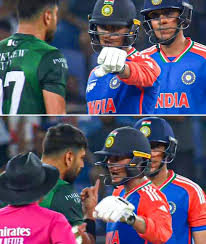Team India Showed Pakistan Their True Place.
The match against India turned into a day Pakistan would want to forget quickly. Their batting started brightly but fell apart when it mattered most. Dropped catches from India gave them extra chances, yet Pakistan could not take advantage.
On the field, their frustration showed. The bowlers had no answers to Abhishek Sharma’s fearless hitting or Shubman Gill’s calm stroke play. Even when India lost a couple of wickets, Tilak Varma walked in and finished the chase with authority, leaving Pakistan helpless.
For fans, it felt like Pakistan were outplayed in every department — batting collapsed under pressure, bowling lacked discipline, and fielding failed to back them up. The tension on the field only added to the sense of defeat, as their aggression could not turn into results.
In the end, Pakistan walked away not just beaten but humbled. The Indian side once again showed why they dominate this rivalry, while Pakistan were left searching for answers.
Whenever India and Pakistan face each other, it is never just another cricket match. It carries history, rivalry, and an atmosphere that feels heavier than usual. On 22nd September 2025, the two teams met again, and as expected, the match had everything – fiery batting, tense moments, mistakes in the field, and drama even after the last ball was bowled.
Sahibzada Farhan’s Shoot-Out Celebration

Pakistan’s opener Sahibzada Farhan was the standout in their innings, and his half-century came with a spark of theatre. After reaching his fifty in quick time, Farhan celebrated in a bold shoot-out style, raising his bat like a gun and mimicking shots toward the stands. The crowd reacted instantly — Pakistan fans roared in approval, while Indian supporters saw it as unnecessary provocation. The gesture injected more tension into the contest, almost as if Farhan was challenging India not just with runs but with attitude. For a brief spell, it lifted Pakistan’s energy, though India’s bowlers soon regained control and muted the effect.
Should ICC Step In?
Farhan’s celebration was more than just a quirky gesture — it carried a message that many fans found distasteful. Cricket is a game followed by millions across borders, and using a “shoot-out style” action on such a stage adds unnecessary tension. Whether intended or not, it creates the wrong impression and risks stirring emotions that go beyond sport. Players have a responsibility to respect the spirit of the game, especially in high-voltage matches like India versus Pakistan. For this reason, many believe the ICC should review such celebrations and take action where required, so the focus stays on cricket rather than provocative symbols.
India’s Answer to the Shoot-Out Celebration
Farhan’s dramatic celebration may have looked like a challenge, but cricket is not won with gestures. If he tried to “fire shots” with his bat, India gave the perfect reply on the field. Abhishek Sharma and Shubman Gill came out all guns blazing in the chase, smashing boundaries and putting Pakistan’s bowlers under pressure from the very first over. Later, Tilak Varma finished the job with calm authority, silencing the effect of Farhan’s antics. In the end, India’s performance proved that real answers are given with runs and wickets, not with celebrations. The scoreboard was the strongest reply, and India’s dominance spoke louder than any gesture could.
Pakistan’s Batting: Bright Start, Slowed Finish
Pakistan came out to bat with intent. Their openers began cautiously but grew in confidence as the overs rolled by. One of their top-order batters played a fluent half-century, timing the ball well and punishing anything short. At that point, it looked like Pakistan were preparing for a total well above 180.
But India’s bowlers fought back. The middle overs brought a change in pace, and Pakistan suddenly found it difficult to find boundaries. Their middle order tried to rebuild, but the innings lost its flow. A few big hits in the final overs helped them close on a fighting total of around 170, but given the pitch and India’s batting depth, it felt just under par.
India’s Fielding Woes: Missed Chances
What kept Pakistan alive in the game were India’s mistakes in the field. Two catches went down, both at crucial moments. Each time, the ball went high into the night sky, only to be spilled. The dropped chances brought groans from Indian fans and cheers from Pakistan supporters.
Fielding errors like these can often flip a contest, and for a while, Pakistan gained energy from India’s lapses. However, the bowlers regrouped quickly, not letting those drops cost too many runs. Still, those mistakes were a reminder that against Pakistan, every small error is magnified.
Tensions on the Field
An India–Pakistan match is never free from emotions. Midway through the game, tempers flared. A few words were exchanged between Abhishek Sharma and Haris Rauf, with gestures and stares adding to the drama. The umpires had to step in to calm things down, but the crowd loved every second of the intensity.

The atmosphere wasn’t just about cricketing skill; it was about pride. Every run saved, every shot played, carried weight. Both teams knew that winning wasn’t just about points on the table—it was about bragging rights.
Abhishek Sharma and Shubman Gill: The Foundation
When India came out to chase, they needed a steady yet attacking start. That’s exactly what Abhishek Sharma and Shubman Gill provided. Their partnership was the backbone of the chase, adding over a hundred runs together.
Sharma was the aggressor, playing fearless shots over the infield and clearing the ropes with ease. Gill, on the other hand, was composed, picking gaps and rotating strike while also punishing loose deliveries. The mix of aggression and calmness completely disarmed Pakistan’s bowling attack.
By the time the first wicket fell, India were well ahead of the required rate, and the crowd could sense where the game was heading.
Tilak Varma: Calm in the Storm
After Sharma’s dismissal, Pakistan saw a small window of opportunity. A couple of quick wickets followed, and suddenly the atmosphere grew tense again. But Tilak Varma walked in and showed remarkable calmness for his age.
He didn’t panic, didn’t try anything fancy—just smart cricket. He nudged singles, punished bad balls, and kept the scoreboard ticking. When the moment came to finish the match, Tilak did it with confidence, ensuring India crossed the line with an over to spare. His finishing touch was a reminder that India’s young talent is ready to handle the biggest stages.
No Handshakes, Only Silence
Even after the match, the drama didn’t end. Players from both sides walked past each other without the customary handshake. It was a silent message that the rivalry still burns strong, and relations remain cold. Fans noticed it immediately, and social media buzzed with reactions.
Cricket is supposed to bring people together, but when it comes to India and Pakistan, the handshake – or the lack of it – often tells its own story.
Conclusion
India’s victory was built on a solid opening stand, steady finishing, and the ability to stay calm despite fielding errors and on-field pressure. Pakistan fought bravely, started brightly with the bat, and fed off India’s mistakes, but they couldn’t sustain the pressure for long enough.
In the end, the night belonged to India. Abhishek Sharma’s fireworks, Gill’s support, and Tilak Varma’s calm finishing sealed the game. The rivalry, however, continues to simmer—on the scoreboard, in the stares, and in the refusal to shake hands.
This wasn’t just a cricket match. It was yet another chapter in the long, heated story of India versus Pakistan.






